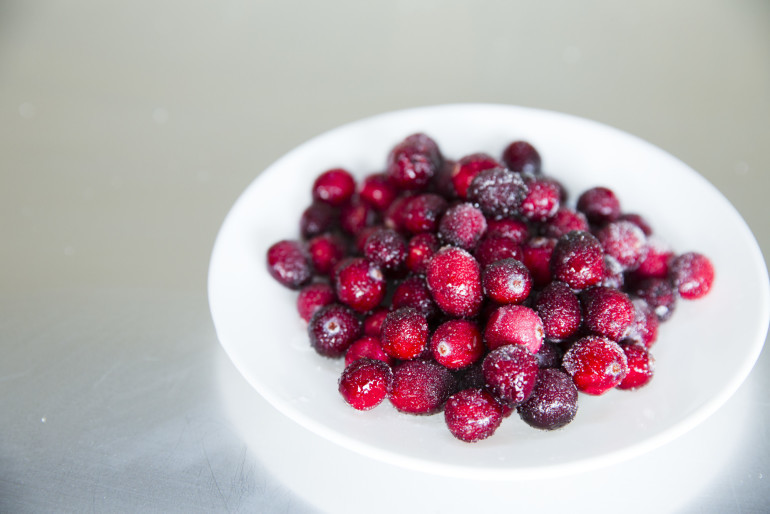Cranberry sauce is the star of Thanksgiving. I grew up eating my Gramma’s homemade cranberry sauce by the container. Literally. I’d have it in my lunch and eat it by the spoonful. No turkey, no bread, just the sauce. In junior high, I learned that the majority of my classmates ate their cranberry sauce from a can. But what blew my mind the most was that canned cranberry sauce looks like a smooth, burgundy log—nothing like the berry-filled sauce I was used to. So what is this cranberry sauce?
The company Ocean Spray produces the majority of the world’s cranberries. For this reason, I’ll be researching their “Jellied Cranberry Sauce” since it’s so popular over the holidays.
The Ingredients
Jellied Cranberry Sauce contains cranberries (phew), high fructose corn syrup, water, and corn syrup. I’ll examine each individually.
Cranberries

Cranberries grow in a specific combination of sand, acidic peat soil, gravel, clay, and fresh water, which is called a bog. The plants are perennials, meaning they grow year after year. The cranberry bogs are flooded in December to insulate them during the cold winter months and again during October to harvest. Unlike other berries that sweeten as they ripen, cranberries remain tart and sour. Therefore, we need a lot of sugar to mask that.
High Fructose Corn Syrup
It’s no secret that the amount added sugar North American’s are consuming each year is significantly higher when compared to 100 years ago. This rising trend is reflected in the fact that diabetes, heart disease, and obesity are also increasing due to an increased dependence on processed foods.
High fructose corn syrup (HFCS), as its name suggests, is derived from corn. It’s cheaper to produce and sweeter than white sugar due to the higher fructose concentration. HFCS doesn’t need to be processed, so it is absorbed immediately into the bloodstream and transported to the liver. Once reaching the liver, HFCS triggers lipogensis and a major spike in insulin.
Corn Syrup

While both HFCS and corn syrup are added sugars, the main difference is their fructose to glucose ratio. Corn syrup is 100% glucose. Corn syrup is favored by the processed foods industry because it’s cheaper to produce and won’t crystallize.
Water

Nothing fancy here—just your regular dihydrogen monoxide diluting the potency of the cranberry sauce.
The Dangers of Corn Syrup

Sugars are a type of carbohydrate—one of the macronutrients we need to survive. In the science world, sugars are referred to as saccharides. Glucose is a monosaccharide, meaning it’s a basic building block (mono means one) for larger and more complex polysaccharides (poly means many). Our body needs glucose to survive; it’s the only fuel our brain uses.
The problems arise when you eat something very high in simple sugars (glucose) that’s also low in fiber, protein, and fat (think gummy candies, cereal, juice, cranberry sauce, white bread, pasta, etc). The high levels of glucose trigger your liver to release a hormone called insulin, which tells your cells to absorb the energy circulating in your blood stream. If your cells have enough energy already, the extra is stored for later in the form of fat. Additionally, since simple carbohydrates are digested super quick, you feel hungry again sooner.
Why Does it Jiggle?
While HFCS and corn syrup may be scary, their presence certainly doesn’t explain the characteristic jiggle of canned cranberry sauce.
Jiggling is actually the result of pectin, which is naturally abundant in cranberries. Pectin is another polysaccharide that is found in fruits and veggies and is responsible for giving food its structure. The less-squishable a fruit is, the more pectin it contains. When heated, it thickens and turns into a gel. Pectin is required when making jams, jellies, and preserves, which makes sense because they also jiggle.
Having grown up eating homemade cranberry sauce, I don’t think I’ll be switching over to the canned variety any time soon. Now that I’m in university and living with my Gramma, she makes sure to cook extra cranberry sauce for me each year. Thanks, Gramma!



